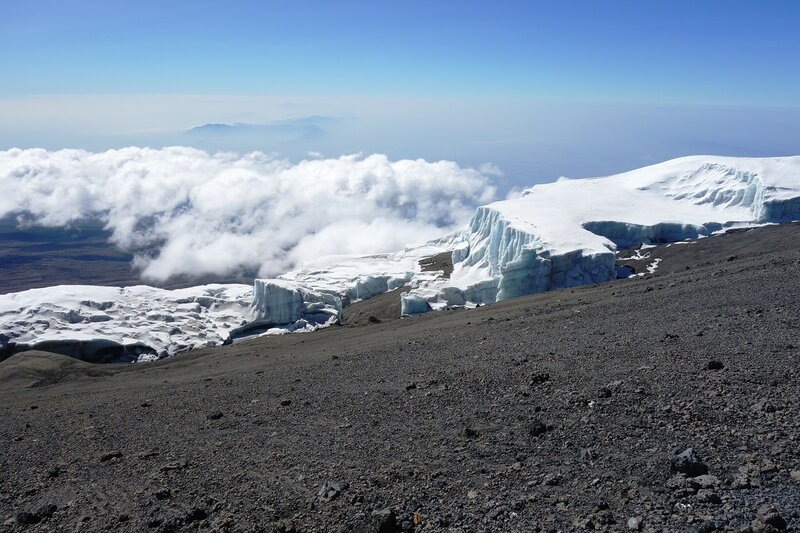
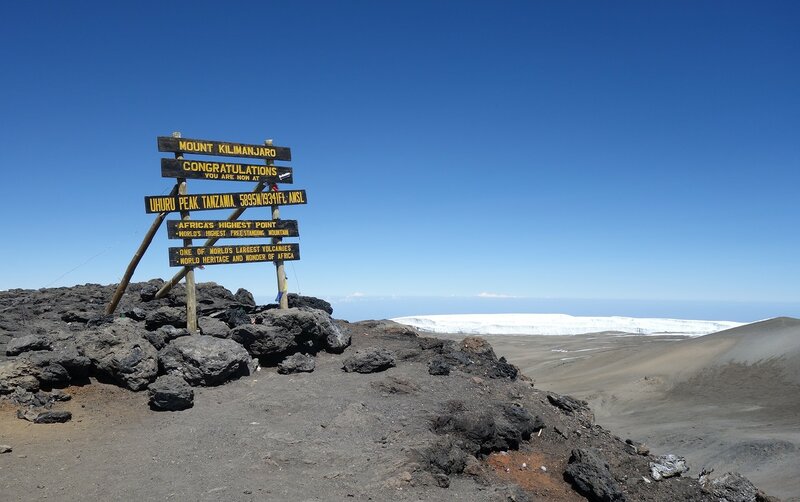
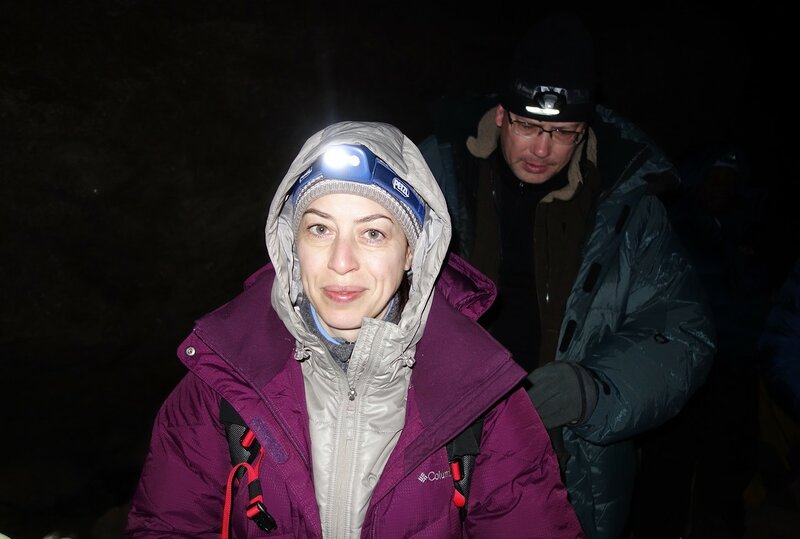


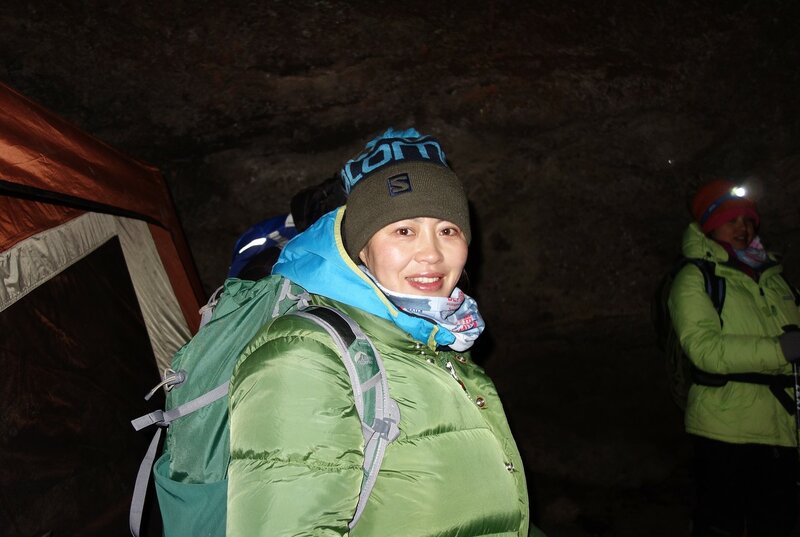

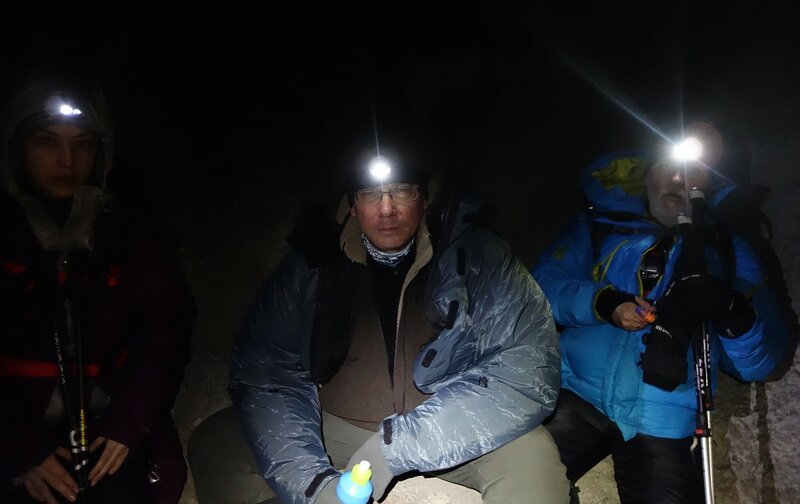
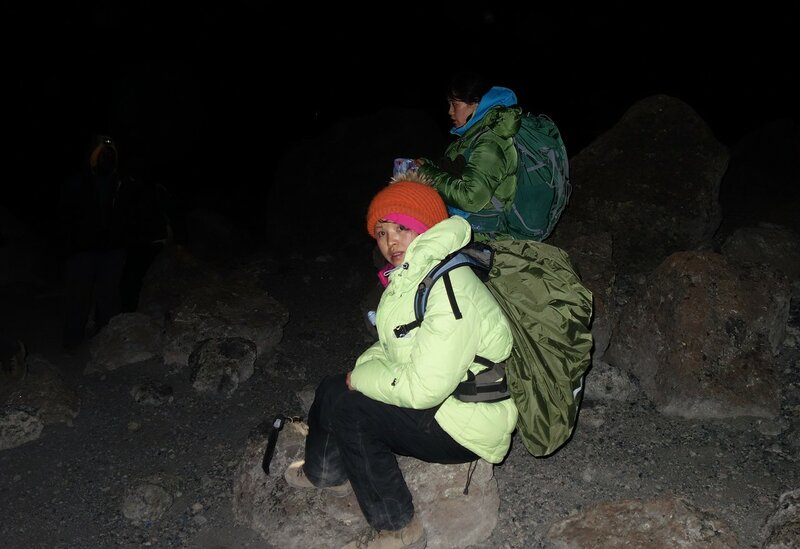
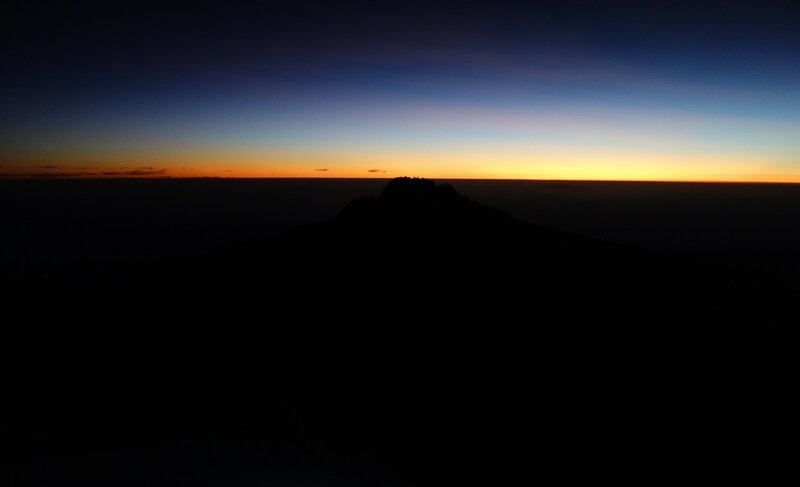
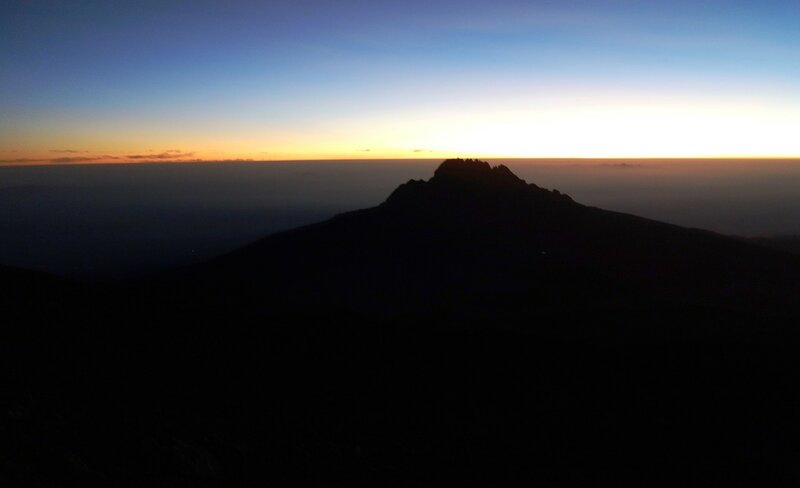



Kilimanjaro.
A group of the 7 Summits Club: Alexander Samsonov, Mikhail and Marina Mendoza-Blandons - successfully climbed the highest point in Africa, Uhuru Peak on the Mount Kilimanjaro. Everything is fine! Now they are down to the ...
A group of the 7 Summits Club: Alexander Samsonov, Mikhail and Marina Mendoza-Blandons - successfully climbed the highest point in Africa, Uhuru Peak on the Mount Kilimanjaro. Everything is fine! Now they are down to the Millennium intermediate camp for the overnight, tomorrow they have to go back from the route. Our congratulations!
The 7 Summits Club this year will send two groups of the North Pole (Last degree). Alexander Abramov will lead the first group, the second - Anastasia Kuznetsova. ATTENTION! Important news. Our explorers have determined the ice ...
The 7 Summits Club this year will send two groups of the North Pole (Last degree). Alexander Abramov will lead the first group, the second - Anastasia Kuznetsova.
ATTENTION! Important news. Our explorers have determined the ice floe on which the Barneo camp to be built. That's it, "address": N 89 * 15'353 "E and 87 * 00'417
IL-76 cargo plane dropped, everything went well. The team started to prepare the runway.
Tractors working well, despite the cold (as well as humans). A lot of work - something has to shoot down and file down that, on the contrary, to fill. Therefore, there is now hot work. They say they will clear the runway is not earlier than after 3-4 days. On Sergey Panteleev photographs show how they have to work...
Everest.
In early April our next Everest expedition will start, as usual led by Alexander Abramov. We return to the highest mountain in the world, the most desired climbing object after the terrible disaster, earthquake, 2015. In some ways, ...
In early April our next Everest expedition will start, as usual led by Alexander Abramov. We return to the highest mountain in the world, the most desired climbing object after the terrible disaster, earthquake, 2015. In some ways, this season will be unusual, something familiar. Our team will be the largest on the northern slopes, we traditionally put most comfortable, beautiful camp, we will do everything to succeed.
You will learn details of the expedition from the head, six-time climber on Everest Alexander Abramov. He will present the team, tell about the features of the current season. That, for the first time as part of our big event will be run purely female team led by Lyudmila Korobeshko. And also we will be able to communicate with the crew RD studio of Valdis Pelsh, which will continue its work on the filming of the movie for the First Russian TV Channel.
Address: Bol Pereyaslavskaya d. 7 Shop "Active Life".
March 31 ... Beginning at 20.00
And also you will be able to listen to reports on the climbing season 2015-2016 in the Southern Hemisphere. Our guides will talk about climbing in Antarctica, South America, Australia and Africa. We will introduce you to new projects, new programs coming summer season in the northern hemisphere. Come, you will find the atmosphere of companionship and a small treat from the 7 Summits Club.
Everest.
March 16th, 2016 the board of Russian Mountaineering Federation formally endorsed the first women expedition to Everest from Russia. This year's 7 women from Russia take part in the Everest expedition, and first time in the history. ...
March 16th, 2016 the board of Russian Mountaineering Federation formally endorsed the first women expedition to Everest from Russia.
This year's 7 women from Russia take part in the Everest expedition, and first time in the history. And probably it never will be later. So the project turns out unique.
Dates of the expedition: from April 12th to May 31th, 2016.
RMF Board Meeting
Project Organizer - 7 Summits Club, with the support of RMF, FAiS Moscow, Red Fox company.
The expedition will be filmed film by a crew of Channel One, namely by RD studio of Valdis Pelsh
Project Manager - Lyudmila Korobeshko - 2-times Mount Everest summiter.
Team's coach Alexander Abramov, the leader of expedition - 6-times Mount Everest summiter.
Alex and Luda: the couple of recordsmen. The only family in the world, in which husband and wife twice fulfilled the program "Seven Summits". The only couple twice climbed to the top of Mount Everest together.
All Team members will be announced on March 31th at the annual meeting (party) of the members of the 7 Summits Club.
Kilimanjaro.
Hi, Seven Summits! It is Artem Rostovtsev, now not from Kilimanjaro, but simply from Tanzania, Tanzania flat. We have successfully come down from the mountain. Now we are enjoying the good weather at the bottom of mountains. There was ...
Hi, Seven Summits! It is Artem Rostovtsev, now not from Kilimanjaro, but simply from Tanzania, Tanzania flat. We have successfully come down from the mountain. Now we are enjoying the good weather at the bottom of mountains. There was no rain, all are surprised that we got wet every day. But climbing is now completed, all returned safe and sound. And full strength for further adventures. Greetings from Africa!
Kilimanjaro.
Hi, Seven Summits! It is Artem Rostovtsev to Kilimanjaro. Our group goes according to the plan, to be exact - everything is on schedule. In the plan we had no rain, but, unfortunately, every day watering. And now ... the ...
Hi, Seven Summits! It is Artem Rostovtsev to Kilimanjaro. Our group goes according to the plan, to be exact - everything is on schedule. In the plan we had no rain, but, unfortunately, every day watering. And now ... the droplets of rain on umbrella. Well, according to the schedule, today we have reached the summit of Kilimanjaro. We have already gone down in the Barranco camp and then go down further. All are very happy. You could not believe it, but I had a very professional camera in the hands of the whole week. I promise great photos. Greetings from Tanzania, Kilimanjaro! Artem Rostovtsev.
Elbrus.
Congratulations to all the women of our 7 Summits Club! And we congratulate all our friends and helpers, wives, lovers, mothers and daughters! Flowers and rejoice! We wish the most beautiful routes, new trips and hikes, vivid impressions ...
Congratulations to all the women of our 7 Summits Club! And we congratulate all our friends and helpers, wives, lovers, mothers and daughters!
Flowers and rejoice!
We wish the most beautiful routes, new trips and hikes, vivid impressions and unforgettable emotions!
We congratulate all the women of the world! Peaceful sky, happiness, love for You!
Kilimanjaro.
Seven Summits, greetings from Africa! It is Artem Rostovtsev, from slopes of Kilimanjaro. Yesterday we began the ascent via route Lemosho and reached the first camp. We met there a lot of black-and-white colabuses. Even today, they ...
Seven Summits, greetings from Africa! It is Artem Rostovtsev, from slopes of Kilimanjaro. Yesterday we began the ascent via route Lemosho and reached the first camp. We met there a lot of black-and-white colabuses. Even today, they saw us off. Now we are moving in the direction of the Shira camp. We are staying at an altitude of about 3400, having a rest. Soon there will be a dinner, we will rest again. Arriving at the camp, there will be a total rest. Beat regards, from misty slopes of Kilimanjaro!
Kilimanjaro.
Marangã Route 22-29 FEBRUARY 2016. Valery Lavrus made an ascent to the summit of Kilimanjaro with Juliana Morozova. We thank him for the detailed photographic report! ...
Marangã Route 22-29 FEBRUARY 2016. Valery Lavrus made an ascent to the summit of Kilimanjaro with Juliana Morozova. We thank him for the detailed photographic report!
Kilimanjaro.
"Kilimanjaro Marathon" took place on February 28 in the Tanzanian town of Moshi in the 14 th time. This time it was attended by about 10 thousand people. Of these, about one thousand were foreigners (from 44 countries). Probably for ...
"Kilimanjaro Marathon" took place on February 28 in the Tanzanian town of Moshi in the 14 th time. This time it was attended by about 10 thousand people. Of these, about one thousand were foreigners (from 44 countries). Probably for the first time among them there were representatives of Russia and Ukraine, and it was members of our group of 7 Summits Club. All the prizes was won by athletes from neighboring Kenya. In men, the first was 31-year-old Kiprotich Kirui with a time of 2: 16.43. For women won Alice Kibora - 2: 38.03. The Guide of the 7 Summits Club Artem Rostovtsev was also as a kind of a winner - he was ahead of all runners with white skin (Mzungu). All of our people finished and deserve congratulations! 7 Summits Club congratulates the heroes!
Our marathoners: Jury Nemtsov, Vladimir Voronin and guide 7 Summits Club Artem Rostovtsev
Elbrus.
Alexander Abramov just returned from Elbrus region and confirms that there snowed. And in this regard, we recall that the Elbrus office 7 Summits Club – it is a meeting place for all the cultured people of the valley, mandatory ...
Alexander Abramov just returned from Elbrus region and confirms that there snowed. And in this regard, we recall that the Elbrus office 7 Summits Club – it is a meeting place for all the cultured people of the valley, mandatory for visiting all the tourists, skiers, snowboarders and climbers. We help all those in need: give in rent the best equipment, coffee and accompany of the good word. Come for the good humor and advice.
And plan to spring-summer climbs of Elbrus only with us!
In addition, we have made a new signboard on the roof of the building. Life is beautiful!
Few days ago - with an old sign
Kilimanjaro.
Hi, Seven Summits Club! It is Artem Rostovtsev. We descended into the valley from Mount Kilimanjaro, we are in the town of Moshi. We went down a few hours ago, and all people brought himself up. And, in general, now you can congratulate us ...
Hi, Seven Summits Club! It is Artem Rostovtsev. We descended into the valley from Mount Kilimanjaro, we are in the town of Moshi. We went down a few hours ago, and all people brought himself up. And, in general, now you can congratulate us on the successful ascent! Tomorrow a part of us goes on safari, another part remains in Moshi. And then we all will run two days later, the Kilimanjaro marathon, or half-marathon. Now the whole town is in the advertising of Marathon and its sponsors…
Kilimanjaro.
Hi, Seven Summits! It is Artem Rostovtsev from Kilimanjaro slopes. We have again a strong north wind from the equator today. We went out at night on the ascent to the "roof of Africa", and at 7-40 a.m. we were at the top. Unfortunately, ...
Hi, Seven Summits! It is Artem Rostovtsev from Kilimanjaro slopes. We have again a strong north wind from the equator today. We went out at night on the ascent to the "roof of Africa", and at 7-40 a.m. we were at the top. Unfortunately, one participant was forced to withdraw yesterday. We sent him down (he is already at the hotel in Moshi). Therefore, on top there were only three people and I form the team of the Seven Summits Club….
Sergey Dolya with his team walked parallel with Artem’s one
Here they are at the same table!
Previous days photos
Kilimanjaro.
Hi, Seven Summits! It is Artem Rostovtsev from Kilimanjaro slopes. Yesterday, our group started to move along the route Lemosho. We quickly came to Shira 1 camp. Today we went to the camp Shira-2 and are sitting here in the clouds. We're ...
Hi, Seven Summits! It is Artem Rostovtsev from Kilimanjaro slopes. Yesterday, our group started to move along the route Lemosho. We quickly came to Shira 1 camp. Today we went to the camp Shira-2 and are sitting here in the clouds. We're attracted to our trip Sergey Dolya, it is a well-known blogger - so that at the end we will have a gorgeous photos.
Greetings from the slopes of Kilimanjaro!
Kilimanjaro.
We want to note that during New Year period (mid Dec 2015 to mid January 2016) 9 groups with a total of 39 people climbed on Kilimanjaro with the "7 Summits Club". Group climbed from different sides of the volcano, by the route ...
Kilimanjaro.
February, 17th our group completed the program, which included climbing the highest peak in Africa, Mount Kilimanjaro, and a two-day safari in the national parks. Rains at the beginning of the campaign gave way to good weather ... ...
February, 17th our group completed the program, which included climbing the highest peak in Africa, Mount Kilimanjaro, and a two-day safari in the national parks. Rains at the beginning of the campaign gave way to good weather ... Just see all the photographs ...
Kilimanjaro.
Hello, Seven Summits! This is Artem Rostovtsev, from Gillmans point, Kilimanjaro. Gillmans point is the point on the crater, where about half of the climbers ends up with a climb on the mountain. We're not finished. Today we went further, ...
Hello, Seven Summits! This is Artem Rostovtsev, from Gillmans point, Kilimanjaro. Gillmans point is the point on the crater, where about half of the climbers ends up with a climb on the mountain. We're not finished. Today we went further, the whole team reached Stella point. Well, after that opinion was divided and half went to the top. And half were waiting for them below. We met at the Gillmans point…
We were on the top at seven in the morning. Now... the way down to the Horombo hut...
There awaits us a festive meal...
Best regards from the group “Seven brave” and their guide Artem Rostovtsev
Kilimanjaro.
Dmitry Kasyanov climbed on the highest summit of Africa with assistance of the 7 Summits Club along Marangu's route. Returning home, he sent us some interesting photos. "My comment is simple. It is excellent opportunity to change ...
Dmitry Kasyanov climbed on the highest summit of Africa with assistance of the 7 Summits Club along Marangu's route. Returning home, he sent us some interesting photos.
"My comment is simple. It is excellent opportunity to change cardinally ambience - other continent, the southern hemisphere, new stars in the sky, people with other skin color, this left-hand traffic on roads, and the wild tremendous nature! It is Tanzania which can be beheld from height of clouds, standing on the highest peak of Africa, Kilimanjaro! It is that you will never forget!"
Kilimanjaro.
Hello Seven Summits! It Artem Rostovtsev. My group arrived at the gate of the "Kilimanjaro" National Park. It is Marangu gate, we go via Marangu route. Yesterday we all the evening finally came together. We even had time to see ...
Hello Seven Summits! It Artem Rostovtsev. My group arrived at the gate of the "Kilimanjaro" National Park. It is Marangu gate, we go via Marangu route. Yesterday we all the evening finally came together. We even had time to see Arusha. This morning we completed the preparation and are now ready to begin the journey to the mountain. Weather - nice, although rainy promise. But we hope that it will be open at the top. Wish us luck! Another hello from Artem Rostovtsev and from the group (we are 7 people) going to Kilimanjaro.
At the hotel in Arusha
Aconcagua.
Guide of the 7 Summits Club Vladimir Kotlyar: Hello everyone! Team "Robinson and the three Musketeers" descended safely to Mendoza! We drank all the wine road)))), and overlooked all eyes on the girls in shorts)))! * About girls ...
Guide of the 7 Summits Club Vladimir Kotlyar: Hello everyone! Team "Robinson and the three Musketeers" descended safely to Mendoza! We drank all the wine road)))), and overlooked all eyes on the girls in shorts)))!
* About girls – it is related only to non-family part of the team)))
This is - a gala dinner with wine and award certificates for climbing the highest peak of South America Aconcagua! We deserve a little holiday !!!
Photos from mountains